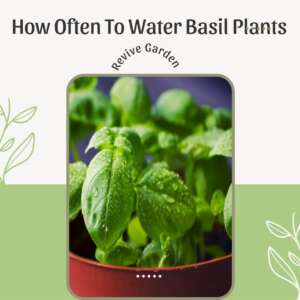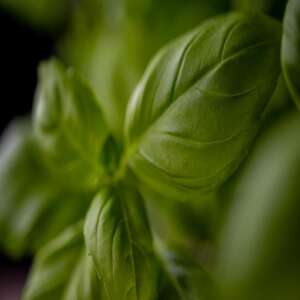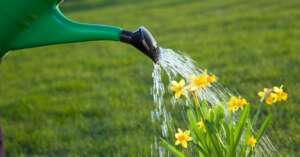Table of Contents
 There are many different hobbies that each person enjoys. Some people take up the practice of gardening as a hobby and others as a profession.
There are many different hobbies that each person enjoys. Some people take up the practice of gardening as a hobby and others as a profession.
Many people grow plants in their gardens and homes for various reasons, including adding beauty to their gardens or simply eating some fresh ingredients.
However, it is imperative to remember that plants require different environments and different levels of water to thrive. Cactus, for example, thrives in desert conditions and does not demand a large amount of water.
In contrast, some plants require a great deal of water to grow.
When it comes to growing basil plants, many questions arise in the gardener’s mind. Our basil plant needs water to grow, so the first question is how often we should water it.
The purpose of this article is to provide you with information about basil plants, how often to water them, and what factors affect the amount of water we should provide to ensure their health.
What Is A Basil Plant?
The first thing we need to learn is what a basil plant is before we learn how often it needs to be watered.
The popular herb basil is indigenous to the South Pacific Islands and southern Asia. This member of the mint family is simple to grow. Ocimum Basilicum, also referred to as basil, is a plant that grows indoors and outdoors and is used in many recipes.
Aromatic leaves from the basil herb plant are frequently used in Mediterranean and Italian cuisine. Additionally, a common Thai component is basil seeds.
Basil is an annual; therefore, it develops quite quickly. It can progress from seed to harvest in as little as three to four weeks. Beginner gardeners would do well to choose this quick-growing herb.
How Often To Water Basil Plants?
Watering basil can sometimes become a little bit tricky. Basil plants require regular moisture in the soil, but too much water can cause root rot, withering, or drooping. Historically, basil plants are supposed to be watered every two days weekly.
Many novice herb gardeners have noticed that either too much moisture (that can result in a rather bright orange basil plant!) or insufficient water will harm, upset, or destroy the basil plants.
Similarly, you must rinse the soil and stem base instead of the leaves since moist leaves can breed bacteria and fungi that cause black spots.
Basil Plant Watering Factors

So many different factors influence water requirements for basil plants. How and where the plant is placed, the pot you use, the soil type, the amount of direct sunlight and warmth it receives, the environment, weather, and temperature levels, the season you are growing in, and whether you are planting your plants inside or outdoors are all important factors that influence the amount of water your basil plants need.
Amount Of Sunlight
One factor influencing the amount of water basil plants require is the amount of sunlight. Basil plants need a lot of sunlight for their growth. This plant needs 6-8 hours of direct sunlight for its growth. In sunlight, the evaporation process occurs.
When basil plants are grown in direct sunlight, they require more water, while when grown in indirect sunlight (like placed behind the window or under the leaves of trees), they require less water.
Time Of Watering
When you water the basil plant also influences the amount of water it needs. The best time for watering the plant is early in the morning. It is recommended to avoid watering the plant at noon by many experts.
This rule is not only for basil plants but for all plants. When you water the plant at noon, most of the water evaporates before the plant has a chance to take it in. For this reason, plants need more water than usual to make up for the water they lose.
Soil Type
The soil type also influences how often you water your plant. Organic matters are the one that increases the water holding capacity of the soil. If your soil is fertile and has a large amount of organic matter, its ability to hold water is much more than infertile soil.
In fertile soil, plants use the water they store, but in infertile soil with less organic matter, the plant needs the water from an external source.
Place Where Plant Is Growing
The place where the basil plant is growing also affects the amount of water and how often it is needed. If the place where your beautiful, odorous plant is growing in a pot, then you need to water the basil plant more often.
Pots have a limited amount of soil and can absorb water only to a certain extent. In pots, you may need to water the plant every day. Alternatively, in the field, there is no limitation of soil, so plants can easily get water from depths and surroundings.
Seasons
The season you are growing the basil plant also influences the amount of water you give it.
In Summer:
On hot summer days, the basil plant needs water after every three days. The amount of water the plant takes from rain must be considered before watering it if the weather doesn’t cooperate and the summer rainy season arrives.
In Winter:
Basil plants mostly grow in warm weather. The plant needs to be moved from the garden to the indoors in winter, and its environment will determine its water requirements.
Watering Tips

Here are a few more pointers to help you get it exactly right and ensure your plant is getting the perfect amount of water:
- Do not confuse colder soil for one that is damp. Especially in the winter, cold, dry earth can feel damp to the touch.
- Regularly check your basil plant’s general health. After some time, you can tell by looking at your plant when it needs water.
- Early in the morning, water any outdoor plants. As the day warms up, this easy action will prevent it from drying out.
- Always remember that the topsoil must feel slightly damp, like a sponge.
- Sometimes the soil is damp on top but dry underneath the roots. To examine the moisture content of the soil deeply, use a wood skewer or even your finger.
- Your plant will require more water as it grows. If the plant’s roots are coming out of its drainage holes, pruning may help reduce watering requirements, or you may want to think about repotting.
To Sum Up
For beginners, watering the plant is quite a challenging process. It’s because they don’t know the factors that affect water usage. In their mind, watering plants is the best way to keep them alive. But that’s not the case for every plant. We hope this article will help you answer the question of how often to water the basil plant.
